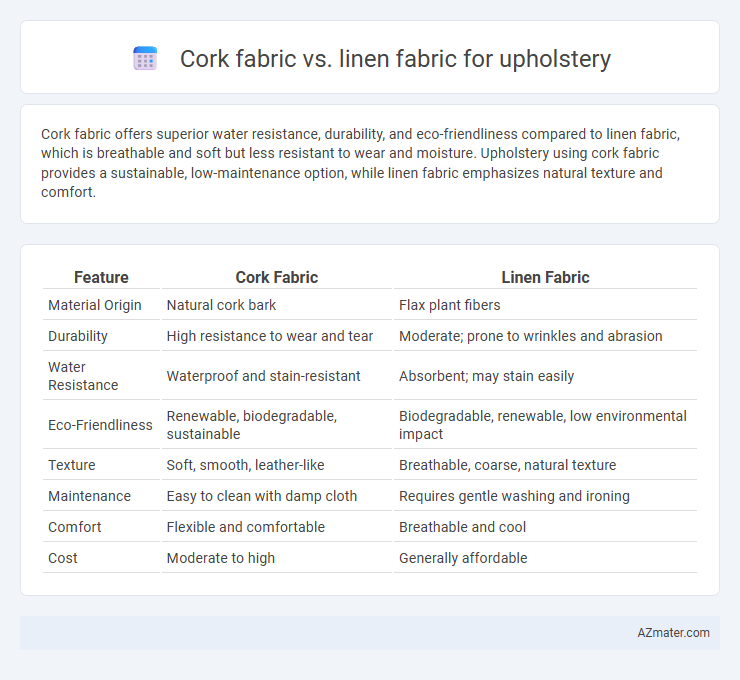Cork fabric offers superior water resistance, durability, and eco-friendliness compared to linen fabric, which is breathable and soft but less resistant to wear and moisture. Upholstery using cork fabric provides a sustainable, low-maintenance option, while linen fabric emphasizes natural texture and comfort.
Table of Comparison
| Feature | Cork Fabric | Linen Fabric |
|---|---|---|
| Material Origin | Natural cork bark | Flax plant fibers |
| Durability | High resistance to wear and tear | Moderate; prone to wrinkles and abrasion |
| Water Resistance | Waterproof and stain-resistant | Absorbent; may stain easily |
| Eco-Friendliness | Renewable, biodegradable, sustainable | Biodegradable, renewable, low environmental impact |
| Texture | Soft, smooth, leather-like | Breathable, coarse, natural texture |
| Maintenance | Easy to clean with damp cloth | Requires gentle washing and ironing |
| Comfort | Flexible and comfortable | Breathable and cool |
| Cost | Moderate to high | Generally affordable |
Introduction to Cork and Linen Fabrics for Upholstery
Cork fabric, derived from the bark of cork oak trees, offers a sustainable, water-resistant, and durable option for upholstery with a unique textured appearance. Linen fabric, made from flax fibers, provides a breathable, strong, and natural material favored for its smooth texture and ability to develop a soft patina over time. Both cork and linen fabrics combine eco-friendly properties with aesthetic versatility, making them popular choices in contemporary upholstery design.
Sustainability: Cork vs Linen Fabric
Cork fabric is highly sustainable due to its renewable harvesting from cork oak trees without harming the tree, promoting biodiversity and reducing deforestation. Linen fabric, derived from flax plants, is biodegradable and requires less water and pesticides compared to conventional cotton, making it an eco-friendly option. Both materials offer low environmental impact, with cork excelling in durability and renewable sourcing, while linen benefits from natural compostability and minimal chemical use.
Durability Comparison: Which Fabric Lasts Longer?
Cork fabric offers exceptional durability for upholstery due to its natural resistance to wear, scratches, and moisture, making it ideal for high-traffic areas. Linen fabric, while breathable and stylish, tends to be less durable under heavy use as it is prone to wrinkling, staining, and abrasion over time. For long-lasting upholstery, cork fabric generally outperforms linen in terms of resilience and maintenance.
Comfort and Texture: Cork vs Linen Feel
Cork fabric offers a smooth, slightly cushioned texture that feels soft yet firm, providing a unique tactile experience ideal for upholstery requiring durability and mild flexibility. Linen fabric features a natural, breathable texture with a crisp yet comfortable touch that becomes softer with use, enhancing upholstery comfort over time through improved airflow and moisture-wicking properties. In terms of comfort, cork provides resilience and temperature neutrality, while linen excels in breathability and a lightweight feel, making both suitable for different upholstery needs depending on the environment and usage.
Aesthetic Appeal: Visual Differences in Upholstery
Cork fabric offers a unique natural texture with a smooth yet slightly textured surface, creating a modern and eco-friendly aesthetic in upholstery. Linen fabric features a distinct woven pattern with subtle slubs that enhance its sophisticated, breathable appearance, bringing a classic and elegant vibe to furniture. The visual differences between cork and linen upholstery lie in cork's sleek, leather-like look versus linen's organic, textured weave, allowing designers to choose based on desired warmth or contemporary style.
Maintenance and Cleaning Requirements
Cork fabric offers exceptional resistance to stains and water, making it easier to maintain compared to linen fabric, which tends to absorb spills and requires gentle cleaning with mild detergents. Cork's natural antimicrobial properties reduce odor and bacteria buildup, while linen upholstery demands regular vacuuming and professional cleaning to prevent fiber damage. Overall, cork fabric's durability and low-maintenance cleaning process make it a practical choice for high-traffic furniture, whereas linen requires more careful handling and upkeep to maintain its appearance.
Hypoallergenic and Health Benefits
Cork fabric offers superior hypoallergenic properties due to its natural resistance to dust mites, mold, and mildew, making it an excellent choice for upholstery in allergy-prone environments. Linen fabric, made from flax fibers, is breathable and moisture-wicking, promoting healthier indoor air quality by preventing the buildup of allergens and bacteria. Both materials provide sustainable, non-toxic options, but cork's antimicrobial characteristics give it a distinct advantage for maintaining a cleaner and healthier living space.
Cost Analysis: Cork Fabric vs Linen Fabric
Cork fabric offers a cost-effective alternative to linen fabric for upholstery, typically priced 30-40% lower due to its sustainable harvesting and simpler production process. Linen fabric, derived from flax fibers, involves more labor-intensive processing, resulting in higher prices and maintenance costs over time. While cork fabric provides durability and water resistance at a lower upfront cost, linen demands additional investment for care and eventual replacement.
Best Use Cases for Each Fabric Type
Cork fabric excels in upholstery for high-traffic areas due to its durability, water resistance, and natural antimicrobial properties, making it ideal for modern, eco-friendly furniture and children's rooms. Linen fabric offers breathability and a soft texture, perfect for light-use areas such as living room sofas and decorative chairs where comfort and style are priorities. Both materials provide unique aesthetics: cork brings a warm, natural look with easy maintenance, while linen delivers timeless elegance with a slightly textured weave.
Final Verdict: Choosing the Right Upholstery Fabric
Cork fabric offers exceptional durability, water resistance, and eco-friendliness, making it ideal for high-traffic areas and moisture-prone environments. Linen fabric provides a luxurious, breathable texture with natural elegance but requires more maintenance due to its susceptibility to stains and wrinkles. Selecting the right upholstery fabric depends on balancing durability needs with aesthetic preferences, where cork suits functional, long-lasting use and linen excels in style and comfort.

Infographic: Cork fabric vs Linen fabric for Upholstery
 azmater.com
azmater.com